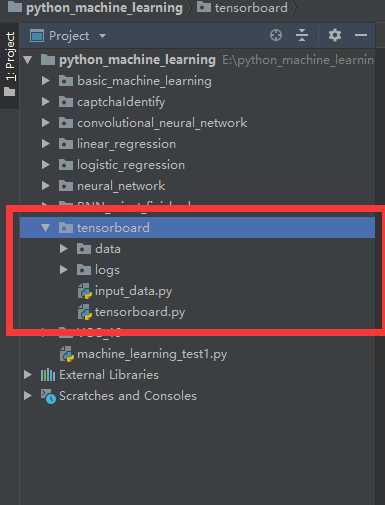标签:版本过低 image save ble next tps lse png python
1.工程目录

2.data、input_data.py的导入
在tensorflow更新之后可以进行直接的input_data的导入
# from tensorflow.examples.tutorials.mnist import input_data
链接:https://pan.baidu.com/s/1EBNyNurBXWeJVyhNeVnmnA
提取码:4nnl
3.神经网络训练算法tensorboard.py
import tensorflow as tf
import input_data
max_steps = 1000
learning_rate = 0.001
dropout = 0.9
log_dir = ‘logs/‘
mnist = input_data.read_data_sets(‘data‘, one_hot=True)
sess = tf.InteractiveSession()
with tf.name_scope(‘input‘):
x = tf.placeholder(tf.float32, [None, 784], name=‘x-input‘)
y_ = tf.placeholder(tf.float32, [None, 10], name=‘y-input‘)
with tf.name_scope(‘input_reshape‘):
image_shaped_input = tf.reshape(x, [-1, 28, 28, 1])
tf.summary.image(‘input‘, image_shaped_input, 10)
def weight_variable(shape):
initial = tf.truncated_normal(shape, stddev=0.1)
return tf.Variable(initial)
def bias_variable(shape):
initial = tf.constant(0.1, shape=shape)
return tf.Variable(initial)
def variable_summaries(var):
with tf.name_scope(‘summaries‘):
mean = tf.reduce_mean(var)
tf.summary.scalar(‘mean‘, mean)
with tf.name_scope(‘stddev‘):
stddev = tf.sqrt(tf.reduce_mean(tf.sqrt(var - mean)))
tf.summary.scalar(‘stddev‘, stddev)
tf.summary.scalar(‘max‘, tf.reduce_max(var))
tf.summary.scalar(‘min‘, tf.reduce_min(var))
tf.summary.histogram(‘histogram‘, var)
def nn_layer(input_tensor, input_dim, output_dim, layer_name, act=tf.nn.relu):
with tf.name_scope(layer_name):
with tf.name_scope(‘weights‘):
weights = weight_variable([input_dim, output_dim])
variable_summaries(weights)
with tf.name_scope(‘biases‘):
biases = bias_variable([output_dim])
variable_summaries(biases)
with tf.name_scope(‘Wx_plus_b‘):
preactivate = tf.matmul(input_tensor, weights) + biases
tf.summary.histogram(‘pre_activations‘, preactivate)
activations = act(preactivate, name=‘activation‘)
tf.summary.histogram(‘activations‘, activations)
return activations
hidden1 = nn_layer(x, 784, 500, ‘layer1‘)
with tf.name_scope(‘dropout‘):
keep_prob = tf.placeholder(tf.float32)
tf.summary.scalar(‘dropout_keep_probability‘, keep_prob)
dropped = tf.nn.dropout(hidden1, keep_prob)
y = nn_layer(dropped, 500, 10, ‘layer2‘, act=tf.identity)
with tf.name_scope(‘cross_entropy‘):
diff = tf.nn.softmax_cross_entropy_with_logits(logits=y, labels=y_)
with tf.name_scope(‘total‘):
cross_entropy = tf.reduce_mean(diff)
tf.summary.scalar(‘cross entropy‘, cross_entropy)
with tf.name_scope(‘train‘):
train_step = tf.train.AdamOptimizer(learning_rate).minimize(cross_entropy)
with tf.name_scope(‘accurecy‘):
with tf.name_scope(‘correct_prediction‘):
correct_prediction = tf.equal(tf.argmax(y, 1), tf.argmax(y_, 1))
with tf.name_scope(‘accuracy‘):
accuracy = tf.reduce_mean(tf.cast(correct_prediction, tf.float32))
tf.summary.scalar(‘accuracy‘, accuracy)
merged = tf.summary.merge_all()
train_writer = tf.summary.FileWriter(log_dir + ‘/train‘, sess.graph)
test_writer = tf.summary.FileWriter(log_dir + ‘/test‘)
tf.global_variables_initializer().run()
def feed_dict(train):
if train:
xs, ys = mnist.train.next_batch(100)
k = dropout
else:
xs, ys = mnist.test.images, mnist.test.labels
k = 1.0
return {x: xs, y_: ys, keep_prob: k}
saver = tf.train.Saver()
for i in range(max_steps):
if i % 10 == 0:
summary, acc = sess.run([merged, accuracy], feed_dict=feed_dict(False))
test_writer.add_summary(summary, i)
print(‘Accuracy at step %s: %s‘ % (1, acc))
else:
if i % 100 == 99:
run_options = tf.RunOptions(trace_level=tf.RunOptions.FULL_TRACE)
run_metadata = tf.RunMetadata()
summary, _ = sess.run([merged, train_step], feed_dict=feed_dict(True))
train_writer.add_run_metadata(run_metadata, ‘step%03d‘ % i)
train_writer.add_summary(summary, 1)
saver.save(sess, log_dir + ‘model.ckpt‘, i)
print(‘Adding run metadata for ‘, i)
else:
summary, _ = sess.run([merged, train_step], feed_dict=feed_dict(True))
train_writer.add_summary(summary, i)
train_writer.close()
test_writer.close()
4.在本地训练完成之后可以进行tensorboard可视化
在terminal窗口输入
tensorboard --logdir "tensorboard/logs" --port=8082
在服务器运行之后访问
http://localhost:8082
ps:可能遇到的问题:
1.浏览器在访问 localhost:8082 时显示空白:
产生原因:tensorflow版本过低
解决办法:更新tensorflow
pip3 install --upgrade tensorflow
更新中可能遇到的问题:在某个盘需要管理员权限
解决办法:打开此电脑-->右键属性(待更改属性的盘)-->安全-->(Users)编辑-->将修改打勾之后应用
标签:版本过低 image save ble next tps lse png python
原文地址:https://www.cnblogs.com/CK85/p/10278259.html